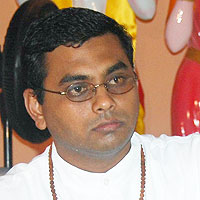 The basic creed of the most ancient of all religions of today, Sanatan Dharma, is enshrined in the following Upanishadic maxim: ‘Ekam Sat Vipraha Bahudha Vadanti’-The Truth is one; it is perceived and spoken of in different names and forms.
The basic creed of the most ancient of all religions of today, Sanatan Dharma, is enshrined in the following Upanishadic maxim: ‘Ekam Sat Vipraha Bahudha Vadanti’-The Truth is one; it is perceived and spoken of in different names and forms.
In essence, this statement characterises the strictly monotheistic nature of Hinduism which is based on the concept that there is only one God, Brahman, who is the Ultimate Cause and Infinite Reality. This Supreme Being pervades every atom of creation.
In cognizance of the fact that man thinks in images, Hinduism postulates the existence of a personal, conditioned Being to suit the temperamental requirements and predilictions of the human mind. Hence, unmanifest Brahman assumes forms and attributes appropriate to the mind-conceivable contours of gender, colour, shape , emotions, passions, etc. Indeed, Brahman, the formless, is assigned form for the convenient communion and communication with God. This ‘sagun Brahman’ (God with attributes) is referred to as ‘Ishwar’ or ‘Bhagavan’. It must be borne in mind, though, that no two minds are at the same level of evolution and understanding and as such, there is a multiplicity of concepts of Ishwar which attests to the three hundred and thirty million forms of the same one God in Hinduism. However, the sages have made it clear in the Upanishads of the monotheism of the Hindu concept of God. The following verse emphasises this point:
‘Call Him by whatever name you like; worship Him in any form you like; it all goes to the Ultimate, Infinite, Supreme Reality’.
God answers to every call whether it is the name of Shiva, Krishna, Buddha , Durga, Jehovah, Tao or any other, provided there is sincerity in the call.
In Chapter 9, verse 25 of Bhagavad Gita, Bhagavan Shri Krishna says: ‘Those who worship the Gods go to the Gods; those who worship the manes reach the manes, those who adore the spirits reach the spirits and those who worship Me come to Me’.
These words of God Himself indicate the free rein that man is given in choosing how he relates with the Divine. Feelings are natural to human beings and, depending on one’s temperament, they are aroused differently in communication. ‘Bhaavas’ or feelings establish a true relationship between the devotee and his Lord. Hinduism has categorised six ‘bhaavas’or relationships that man usually uses in his intercession with God. These are:
- Daasya- Master/Servant eg. Shri Ram/Tulsidas
- Vatsalya- Child/Parent eg. Shri Raam/ Kaushalya
- Maadhurya- Beloved/Friend eg. Krishna/Radha
- Kaanta- Husband/ Wife eg. Krishna/ Rukmini
- Sakhya- Friend/Friend eg. Krishna/Arjuna
- Shatru- God/Enemy eg. Krishna/ Kans
The wide scope of expression demonstrates the all-embracing nature of this eternal religion of Sanatan Dharma.


